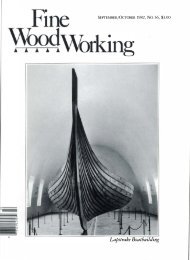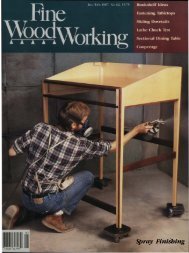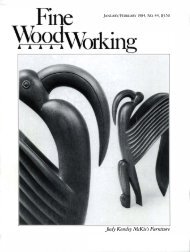NOVEMBER/DECEMBER 1983, No. 43, $3.50 Making ... - Wood Tools
NOVEMBER/DECEMBER 1983, No. 43, $3.50 Making ... - Wood Tools
NOVEMBER/DECEMBER 1983, No. 43, $3.50 Making ... - Wood Tools
Create successful ePaper yourself
Turn your PDF publications into a flip-book with our unique Google optimized e-Paper software.
Splitting Out a Firewood Tote<br />
This projea gets you started with green wood<br />
by Wizyne Ladd<br />
The ftrst time I met Vermont chairmaker Dave Sawyer, he<br />
was sitting on a shaving horse making a pitchfork. The<br />
only sounds were the creaking of the horse and the hiss of his<br />
drawknife. Having played at woodworking myself, I looked<br />
around the shop for the familiar router, bench saw and jointer,<br />
but saw only bits, braces, hand planes and, against one<br />
wall, a ftne bench. Sawyer asked if I knew of any ash trees for<br />
sale. As it turned out, a huge, straight ash had blown over on<br />
my land. The following week, wedges in hand, Sawyer came<br />
over to split the ttunk. We carried the splits to my car, then<br />
to his shop. The next day, I was amazed to fm d that he had a<br />
pitchfork made from my tree.<br />
I was so impressed with Sawyer's skill and practiced eye for<br />
simple, sturdy woodworking that I spent the following year as<br />
his part-time apprentice. One of the ftrst projects I learned<br />
was the log carrier shown here. Though the graceful bow<br />
gives the tote a fragile look, I've discovered that it can carry<br />
more wood than I care to heft at one time. And you can wrap<br />
twine around the foot rails and hang it from a rafter to make<br />
a wonderfully<br />
green<br />
sturdy indoor child's swing.<br />
Splitting wood-<strong>Making</strong> the log carrier from riven<br />
green wood affords some important advantages over sawn,<br />
kiln-dried wood. First, you can go straight to your woodlot,<br />
fell a tree, and then split, shave and assemble it into a ftnished<br />
produa, all in a matter of houts. Split along the grain<br />
instead of being sawn across it, riven wood is stronger than<br />
sawn wood, and satisfyingly easy to cut, bend and shape<br />
while green. You don't have to glue your projects together,<br />
either. Whittled tenons, dried over the woodstove, slip into<br />
mortises bored in wet wood, where they swell and lock the<br />
joint. For working green wood, you'll need two steel wedges,<br />
a mallet and a froe for splitting. A drawknife, spokeshave,<br />
brace and bit, and shaving horse complete the toolkit. For a<br />
shaving horse design, see the box on p. 41.<br />
1: Fig. Splitting<br />
Firs t split removes<br />
unusable heartwood.<br />
sequence<br />
Green-wood tote holds all the wood you want to carry.<br />
I use white ash for my carriers because it's the best bending<br />
wood that grows on my land. Hickory and oak also bend<br />
well. Whatever wood you choose, it should be straightgrained.<br />
Read the bark. If it's free of swirls and scars, chances<br />
are the wood will be the same. A 5-ft. log, 6 in. in diameter,<br />
will provide enough wood for a dozen carriers.<br />
Quarter your log by ftrst driving a wedge into one end and<br />
then leapfrogging the wedges up the side. If you've got a big<br />
log, split it into eighths. I use wedges only to get the log into<br />
manageable splits or bolts, which I then carry to the shop,<br />
where I split the parts closer to the final size with a froe.<br />
You'll need a brake-a mechanism that props the bolts at<br />
about 350 from the vertical for froeing. The crotch of a fallen<br />
tree or two heavy logs adjacent to each other make a suitable<br />
brake. Work with the bolt angled toward you.<br />
Learning to froe is easy<br />
froe<br />
if you remember that this tool<br />
doesn't cut the wood, but rives or splits it along the material's<br />
natural fibers. Start the with a wack or two from the<br />
mallet. Then set the mallet aside, and continue the split by<br />
alternately levering the fibers apart and advancing the tool<br />
into the split. Split the unusable heartwood off the point of<br />
the quarter first. Then follow the sequence shown in ftgute 1,<br />
splitting in halves so that an equal amount of wood on each<br />
side of the froe will keep the cleave going straight down the<br />
length of the bolt instead of running off and exiting where<br />
you don't want it to. If the split does run out, put the heavy<br />
side down, and with the heel of your hand, put weight on<br />
this side of the split only. This will make the heavier half<br />
"give up" its grain. You can tell by the sound whether you<br />
39












